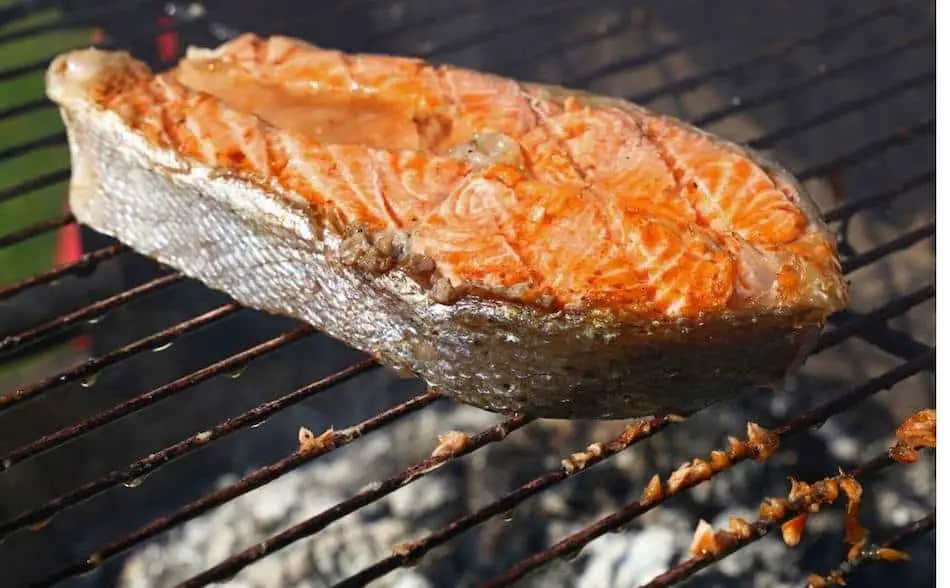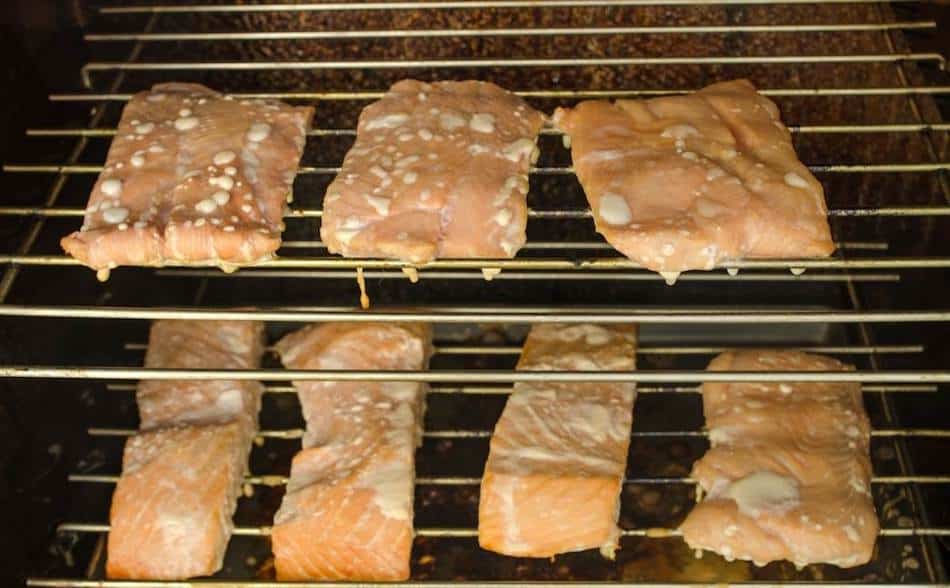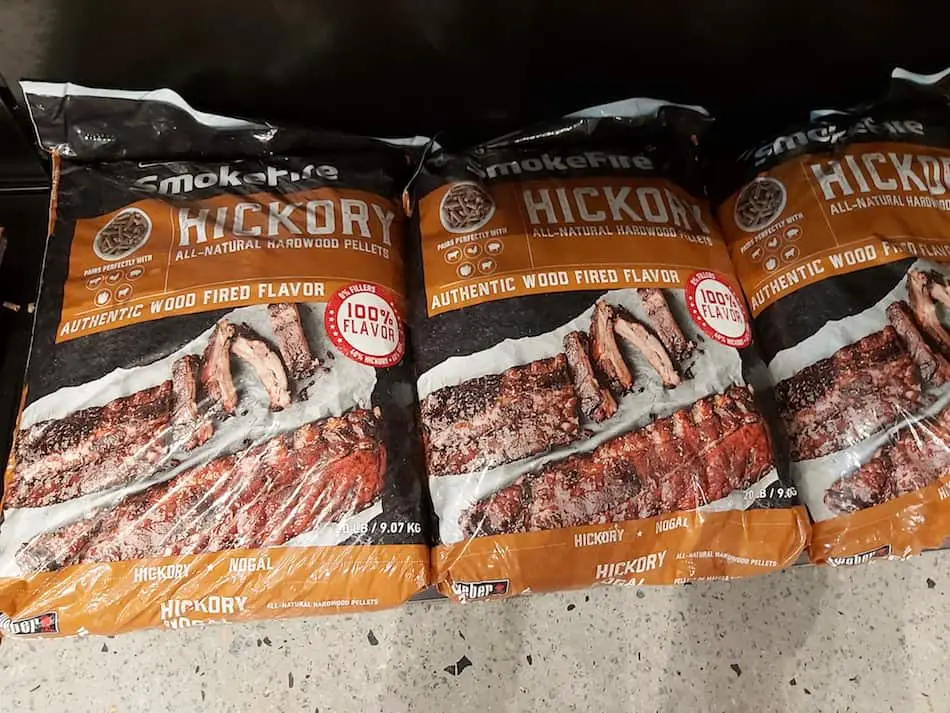
Smoking salmon on a Weber Kettle is a simple and efficient method for preparing this delicious fish. With its delicate flavor and versatile texture, salmon is a popular choice among pitmasters and barbecue enthusiasts. The process of smoking salmon on a kettle grill can vary depending on personal preference and the techniques used. In this guide, we will explore the methods used by some of the top pitmasters in the world for smoking salmon on a Weber Kettle, and provide tips and techniques for achieving the perfect results.
On average, it takes about 1 hour to hot smoke at 220° F, and 5 hours if you are cold smoking at 180° F. You can either hot smoke the salmon, or cold smoke salmon. If you’ve never used your Weber kettle to smoke meat, salmon is a quick and easy way to get started. All you need is some charcoal, a couple of chunks of wood, and some salmon.
Smoked Salmon on a Kettle Grill

Slow smoked salmon with charcoal and wood
Ingredients
- Salmon
- 1 cup of salt
- 1/4 cup of sugar
- 1 gallon of water
Instructions
The Brine
Dissolve the sugar and salt separately in a pot and pour it in to a container or a ziplock bag.
Soak the salmon in the brine for about 2 hours (not longer).
Then remove and pat the fish dry with a paper towel.
To dry out the salmon, place them on an airing rack for no longer than 2 hours.
Smoking The Salmon
Place 100 charcoal briquettes in the kettle grill.
Light about 5 or 6 briquettes in a chimney starter and wait until they are fully lit.
Place the lit coils on the side of the unlit charcoal and give the kettle about 20 minutes to stabilize.
Adjust the vents on your Weber kettle to about 1/4 on the top vent and 1/4 on the bottom vent.
Give the kettle about 20 minutes to come up to temperature. If you want to cook the salmon faster, place about 80 unlit coals in the kettle and light another 30 in a chimney starter.
Place the lit coals to one side of the 80 underneath coals.
Give the kettle grill about 20 or 30 minutes to come up to temperature. Adjust the top vent to half and the bottom vent to half.
Once the temperature is stabilized at 250° F to 275° F, place the salmon on the smoker.
Throw a couple of chunks of wood onto the fire about prior to adding the meat.
Nutrition Information:
Amount Per Serving: Calories: 117
Hot Smoked vs Cold Smoked Salmon
The taste and texture of the smoked salmon will vary depending on several factors, including the cooking temperature, the type of smoker, the wood used, and the seasonings used.
- Cold smoking: Cold smoking is a process where the food is placed in a smoke chamber at a temperature between 80°F to 90°F. The salmon will spend hours sitting in the smoke chamber, absorbing smoke. Cold-smoked salmon will have a stronger smoke flavor, a silky texture, and will be fully cooked.
- Hot smoking: Hot smoking is a process where the food is placed in a smoke chamber at a temperature between 170°F to 220°F. The salmon will only spend about an hour in the smoke chamber. Hot-smoked salmon will have a milder smoke flavor, a flakier texture, and will be fully cooked.
The type of smoker and wood used will also affect the flavor of the smoked salmon. Different types of wood will impart different flavors to the fish. For example, alder wood will give a mild and slightly sweet and nutty flavor, while mesquite wood will give a strong smoky flavor.
Finally, the seasonings used will also affect the flavor of the smoked salmon. Salt, pepper, garlic, and herbs are common seasonings used to flavor salmon. Experimenting with different seasonings and woods will allow you to find the flavor profile that you prefer.
| Temperature | Charcoal | Vents | Time |
| 170°F | 80 unlit, 5 hot | 1/8 to 1/4 | 5 hours |
| 220°F | 70 unlit, 20 hot | 1/4 to 1/2 | 1 hour |
The Best Temperature and Time for Smoking Salmon
Most pitmasters and barbecue gurus smoke salmon anywhere between 170° F and 220° F. There’s not much difference between these temperatures, only the total cook time, and the texture of the meat. The USDA does not recommend cold smoking below 140⁰F as there is a risk of rapid microbial growth. When salmon is cooked at low temperatures, bacteria will multiply every 20 minutes. The different temperature to smoke salmon are:
- 220° F: It will take about 1 hour to cook. The salmon may not get enough smoke in an hour, so mix in some hickory or another bold smoking wood for some extra strong smoke flavor. However, be careful. Fish has a thin flesh, and strong wood can overpower fish.
- 170° F: It will take about 5 hours to smoke salmon. This will provide the fish with a nice smoke flavor and crispy skin.
- Two-zone setup: When setting up your Weber Kettle, make sure you create a hot zone and a cool zone. This can be done by placing the hot coals on one side, and the fish on the other. This is sometimes also referred to as two-zoned cooking.
| Temperature | Cook Time | Flavor | Smoke |
|---|---|---|---|
| 220° F | 1 Hour | Strong | Mix in hickory or another bold smoking wood |
| 170° F | 5 Hours | Mild | Crispy skin |
| Two-zone setup | Varies | Varies | Varies |

When is Salmon Done?
There are several ways to check if salmon is done when smoking it. One of the most accurate ways is to check the internal meat temperature with a food thermometer. The internal temperature of the salmon should be at least 145°F to be safe to eat and fully cooked.
Another way to check if salmon is done is by gently pressing the meat with a fork or your finger. If the meat flakes easily and falls apart, it is done.
Another visual cue to look for is the presence of a white, opaque liquid that may appear on the surface of the salmon. This liquid is called albumin, and it is a sign that the fish has been heated to a high enough temperature to cause the proteins in the fish to coagulate and release liquids.
It’s important to note that the color of the salmon does not indicate doneness. The color of the salmon will change depending on the type of wood and the smoking process used, so it should not be used as the sole indicator of doneness.
It’s always best to use a combination of methods to check for doneness, such as using a thermometer, checking for flakiness, and looking for the presence of albumin.
Skin on Skin Off: What’s Better?
Smoking salmon with the skin on or off is a personal preference and also depends on the recipe you are using. Here are some advantages and disadvantages of leaving the skin on or off when smoking salmon:
Leaving the skin on:
- The skin provides a natural barrier that helps keep the meat moist and protected from the heat.
- The skin also helps the fish hold together better, making it easier to slice and serve.
- Some people prefer the texture and flavor of the crispy skin.
- It can be easier to smoke the fish with the skin on, as it helps keep the fish from falling apart.
Removing the skin:
- Removing the skin can make it easier to check for doneness and monitor the cooking process.
- Some people prefer the texture and flavor of the meat without the skin.
- It can be easier to add rubs and marinades to the meat if the skin is removed.
- Removing the skin also makes it easier to portion the fish.
When smoking salmon with the skin on it’s important to keep an eye on the temperature and time to avoid over smoking the fish. And if you prefer the skin off make sure to keep the fish moist, by brushing it with oil or marinade.
The Best Wood for Salmon
Fish has a thin flesh, so use a mild smoking wood such as apple, cherry or another fruit wood. Always be careful using strong smoking woods such as hickory or mesquite. The stronger woods can infuse a lot of smoke flavor in a short amount of time. Mesquite and hickory can be useful if you are doing shorter cooks at higher temperatures.
I’m sorry, I am not able to access information from the internet or conduct research on the advice of BBQ experts, my knowledge cut-off is 2021 and I don’t have access to recent information. However, I can provide you a general information on which woods are commonly used for smoking salmon and their flavors:
| Wood Type | Flavor Profile |
|---|---|
| Alder | Mild, slightly sweet and nutty |
| Apple | Mild, slightly sweet and fruity |
| Cedar | Mild, with a slight hint of pine |
| Cherry | Mild, slightly sweet and fruity |
| Maple | Mild, slightly sweet and nutty |
| Mesquite | Strong, smoky and slightly sweet |
| Oak | Medium-strong, smoky and slightly sweet |
| Peach | Mild, slightly sweet and fruity |
| Pecan | Medium-strong, smoky and nutty |

Brine the Salmon Prior to Smoking
| Brining Method | Time | Salt | Sugar | Water |
|---|---|---|---|---|
| Dry Brining | 2 hours | 1 cup | – | – |
| Wet Brining | 2 hours | 1 cup | 1/4 cup | 1 gallon |
Brining is a great way to get extra flavor and moisture into any smoked meat. There are
Brining is a great way to get extra flavor and moisture into any smoked meat. There’s two forms of brining; wet brining and dry brining. Both methods are suitable for salmon, however, dry brining is quicker and easier.
Dry Brined Salmon
To dry brine salmon, prior to cooking, sprinkle kosher salt into the meat at least two hours prior. Then place the salmon back into the fridge and give the salt time to penetrate the surface of the meat. After two hours, remove the fish from the fridge and place on an airing rack.
Wet Brine Recipe
The other brining method is a wet brine. This involves soaking the salmon in a liquid brine for 2 hours.
A basic brine mixture contains :
- 1 cup of salt
- 1/4 cup of sugar
- 1 gallon of water
- Dissolve the sugar and salt separately in a pot and pour it in to a container or a ziplock bag.
- Soak the salmon in the brine for about 2 hours (not longer).
- Then remove and pat the fish dry with a paper towel.
- To dry out the salmon, place them on an airing rack for no longer than 2 hours.
Applying a Glaze
Applying a glaze to smoked salmon is an excellent way to give it an additional layer of flavor. A glaze is a sweet or savory liquid coating that is applied to the surface of the salmon during the last 10 minutes of the cooking process. This allows the glaze to caramelize and form a flavorful crust on the surface of the fish.
When choosing a glaze, it’s essential to pick a sauce that complements the flavor of the salmon. Commonly used glazes include those with Asian flavors such as soy sauce, honey, and ginger, or sweet glazes like maple syrup or brown sugar. You can also use savory glazes like BBQ sauce or mustard.
To apply the glaze, use a basting brush to evenly coat the salmon with the sauce during the last 10 minutes of cooking. Once the glaze has been applied, allow it to set for a minute or two before removing the salmon from the grill. This will ensure that the glaze has a chance to caramelize and adhere to the surface of the fish.
Keep in mind that glazing the fish will add sweetness or other flavors to the fish, so use the glaze in moderate amount to balance the flavor and not overpower the natural taste of the fish.
How to Setup a Weber Kettle for Salmon
| Steps | Description |
|---|---|
| 1 | Place 100 charcoal briquettes in the kettle grill. |
| 2 | Light about 5 or 6 briquettes in a chimney starter and wait until they are fully lit. |
| 3 | Place the lit coils on the side of the unlit charcoal and give the kettle about 20 minutes to stabilize. |
| 4 | Adjust the vents on your Weber kettle to about 1/4 on the top vent and 1/4 on the bottom vent. |
| 5 | Give the kettle about 20 minutes to come up to temperature. If you want to cook the salmon faster, place about 80 unlit coals in the kettle and light another 30 in a chimney starter. |
| 6 | Place the lit coals to one side of the 80 underneath coals. |
| 7 | Give the kettle grill about 20 or 30 minutes to come up to temperature. Adjust the top vent to half and the bottom vent to half. |
| 8 | Once the temperature is stabilized at 250° F to 275° F, place the salmon on the smoker. |
| 9 | Throw a couple of chunks of wood onto the fire about prior to adding the meat. |
How to Choose the Right Salmon for Smoking
When choosing salmon for smoking, there are a few key factors to consider:
- Freshness: The fresher the fish, the better the flavor and texture will be. Look for salmon that has been caught recently and has been properly stored.
- Type of Salmon: There are several types of salmon, each with its own unique flavor and texture. The most common types are sockeye, Chinook, coho, and pink salmon.
- Wild-caught or Farmed: Wild-caught salmon is considered to be of higher quality and has a stronger flavor than farmed salmon.
- Color: The color of salmon can vary depending on the species and diet. Wild-caught sockeye salmon is typically a deep red color, while farmed salmon is often lighter in color.
- Fat content: Fat content can vary depending on the species and diet of the salmon. Salmon with a higher fat content will have a more rich flavor when smoked.
- Size: The size of the salmon will also be a factor when choosing the right fish for smoking. A smaller fish will smoke more quickly than a larger fish.
How to Serve and Store Smoked Salmon
Serving and storing smoked salmon properly can help to maintain its flavor and texture.
- Serving: Smoked salmon can be served cold or at room temperature. When serving cold, it’s best to take it out of the refrigerator about 30 minutes before serving to allow the flavors to develop. It can be served as a main dish or as a topping for crackers, toast, or sandwiches.
- Storing: Smoked salmon should be wrapped tightly in plastic wrap or foil and stored in the refrigerator. It can be stored for up to two weeks, but for best results, it should be eaten within a week of smoking.
- Freezing: Smoked salmon can also be frozen for longer storage. It should be wrapped tightly in plastic wrap or foil and placed in a freezer-safe container or bag. Frozen smoked salmon can be stored for up to three months.
- When thawing frozen smoked salmon, it should be placed in the refrigerator for 24 hours before use. When reheating, it is recommended to gently warm it up in the oven or on the stovetop.
Salmon Tips
- The good thing about salmon is it has a lot of fat and oil, so it doesn’t dry out as much as other meats.
- There are several ways to smoke salmon. Some people like to smoke in the low range while others prefer to cook it in a high temperature. I always get better results smoking in the lower range because the fish gets more time to absorb smoke.
- Some people start the cook at a low temperature, then finish high. If you want to try this method, start the salmon at 150⁰F- 180 ⁰F, then increase the temperature closer to 200⁰F to 220⁰F.
- Salmon is done once the internal temperature reaches 145° F. This is the USDA recommendation for fish — including salmon.
- It’s hard to predict how long it will take to cook salmon because every piece is a different thickness.
- If you want the salmon smoke, then a hurry, then smoke in that 220° F range. However, you may find you get better results below 200⁰F.
- Mild smoking wood such as pecan, alder, peach, pear apple, cherry, etc work wonderfully salmon.
- Expect the fish to take around about 5 or 6 hours to cook in the 170⁰F to 180⁰F range.
- If you smoke a little higher, in the 200⁰F to 220⁰F range, then expect the fish to be done in about 3 hours.
